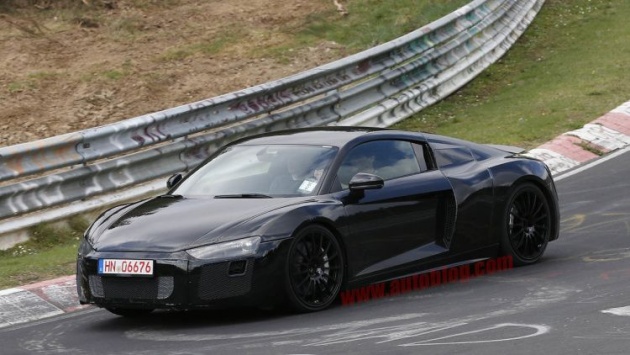
More details from the Audi R8 event at Spain's Ascari circuit have met the Internet, and they provide more intel on the supercoupe will evolve over the second generation. First, they note some small differences in stance with this new car, being wider than the current car and sitting 30 millimeters (1.18 inches) lower. Compared to its Lamborghini Huracán brother, it gets three extra centimeters in the wheelbase.
Filling out the power numbers, the 'entry-level' V10 engine at launch rolls out 540 horsepower and 399 pound-feet of torque, does the 0-60 mile per hour dash in 3.5 seconds, and hits a top speed of 200 mph. The V10 Plus model rocks 620 hp and 412 lb-ft, which slices 0.3 seconds off that acceleration time and adds five more mph to the top speed. They'll transfer their power through a seven-speed S-tronic that shifts faster than before, and it will in turn send power through an electronically-controlled clutch at the front axle and a constantly variable limited-slip differential at the rear axle. The power split is said to default to 42/58 front-to-rear, but 100 percent of the torque can be sent fore or aft.
Benchmarked against the 991-series Porsche 911, driving sensations travel through an electromechanical steering setup that can be had with a variable rack if preferred, leading to standard 19-inch wheels with the option of 20-inchers and tires developed specifically for this car. A Performance setting offers dry, wet, and snow modes; that first setting turns the ESC off except for situations of impending doom, and Audi racer and test driver Frank Stippler told Top Gear that understeer is reduced, to which TG added "it oversteers at will." Stippler said it's "a lot closer to the GT3 race car than ever before," and even though it's "a lot" less intense than the Huracan, it's just as fast on the track. His estimate is that the new R8 will lap the Nürburgring between ten and 15 seconds faster than the current car.
R8 technical lead Roland Schala said the new chassis opens up new avenues of development because "there's no problem to change it," mentioning models like a Clubsport or Superleggera as no longer forbidden. Differentiation could come from a wider engine mix, too. Markets like China need smaller displacements, so Audi's twin-turbo V8 is expected to join the line-up at some point, bringing 500 horsepower. After that, Schala said they're "not quite sure what the next step is," but that a "V6 is a perfect engine for this car." Schala didn't mention it, but there are rumors that the next RS4 and RS5 will get a twin-turbo V6 with something like 425 horsepower, so it might find a home here, too. A diesel is a left-field option, but the weight and accessories needed to make it work, and, paradoxically, it's prodigious torque, might keep it from working for this car, Audi's focus being "all about high revolutions right now."



